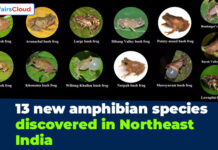 According to the ‘Protected Planet Report 2020’ released by United Nations Environment Programme – World Conservation Monitoring Centre (UNEP-WCMC) and the International Union for the Conservation of Nature (IUCN) & Supported by National Geographic Society, around 21 million square kms (which is 7 times the size of India) have been added within the Protected & Conserved Areas of the world since 2010.
According to the ‘Protected Planet Report 2020’ released by United Nations Environment Programme – World Conservation Monitoring Centre (UNEP-WCMC) and the International Union for the Conservation of Nature (IUCN) & Supported by National Geographic Society, around 21 million square kms (which is 7 times the size of India) have been added within the Protected & Conserved Areas of the world since 2010.
- It brings the total percentage of earth’s land which is protected/conserved to 64%, which is just a fraction short of the Aichi Biodiversity Target 11 (Protecting/Conserving 17% of Earth’s land and 10% of its marine environments by 2020).
- Around 82% of countries and territories have increased their share of protected area and coverage of Other Effective area-based Conservation Measures (OECM).
- The addition of 21 million square kilometres indicates that 42% of the world’s protected and conserved areas were added during 2010-20.
Protected Planet Report
- It is a biennial report which assesses the state of protected and conserved areas around the world.
- The 2020 edition provides the final report on the status of Aichi Biodiversity Target 11, which was set during the 2010 Convention on Biological Diversity conference held in Japan’s Aichi prefecture.
- For the 1st time, the report includes data on OECMs.
Key Points
i.Aichi Biodiversity target is a set of 20 targets of the Convention on Biological Diversity, the main targets are
- Conserve 17% of land & island water ecosystems
- 10% of coastal water & oceans by 2020.
ii.As of May 2021, 22.5 million square kilometres of land and inland water ecosystems (16.64%) and 28.1 square kilometres of coastal waters and ocean (7.74%) are within protected areas and OECMs.
iii.The ongoing efforts to identify currently conserved or managed privately or by Indigenous and local communities will push the total conserved areas past the 17% goal in Aichi Target 11.
iv.Although the Protected area coverage in oceans have tripled since 2010 to 28.1 million square kilometres, it falls short of meeting the 10% goal of marine environments worldwide.
OECM & Key Biodiversity Areas (KBA)
i.OECM is a geographically defined area other than a Protected Area which is governed and managed to achieve outcomes for conservation of biodiversity.
ii.On an average, 62.6% of Key Biodiversity Areas (KBA) either fully or partially overlap with protected areas and OECMs.
- Average percentage of each KBA within protected areas and OECMs is 43.2% for terrestrial; 42.2% for inland water and 44.2 % for marine.
- All areas (terrestrial, water & marine) showed ~ 5% increase in size since 2010.
- Marine and Coastal areas recorded the maximum growth.
iii.Proper conservation of protected and conserved areas will help in preventing further ecosystem degradation and consolidate progress on the UN Decade on Ecosystem Restoration, which is set to be launched on the World Environment Day (June 05, 2021).
Recent Related News:
January 2, 2021, India is all set to co-chair the International Union for Conservation of Nature (IUCN)-supported Asia Protected Areas Partnership (APAP), a regional forum to conserve wildlife habitats for three years. In this tenure India will assist other Asian countries in managing their protected areas.
About UNEP-WCMC
UNEP-WCMC stands for United Nations Environment Programme – World Conservation Monitoring Centre
Director – Neville Ash
Headquarters – Cambridge, UK
About International Union for the Conservation of Nature (IUCN)
President – Zhang Xinsheng
Headquarters – Gland, Switzerland




